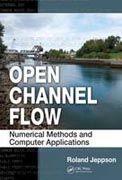
Open channel flow: numerical methods and computer applications
Jeppson, Roland W.
Suitable for a graduate-level open channel flow or hydraulics course, this comprehensive book starts with basic principles and gradually advances to complete problems involving systems of channels that require the simultaneous solutions of systems of nonlinear equations. The text offers numerous practical examples and end-of-chapter homework problems that expand upon the methodologies presented and encourage readers to apply the related principles in practice. The accompanying CD-ROM provides solutions and programs with qualifying course adoptions. INDICE: Dimensions, Terminology, and Review of Basic Fluid Mechanics Introduction One-, Two-, and Three-Dimensional Flows Steady versus Unsteady Flow Uniform versus Nonuniform Flow Prismatic versus Non-Prismatic Channels Subcritical, Critical, and Supercritical Flows Turbulent versus Laminar Flow Review of Basic Fluid Mechanics Principles Physical Properties of Fluids and Their Effects on Open-Channel Flows Conservation of Mass, or Continuity Equations Energy Principle Problems Energy and Its Dissipation in Open Channels Introduction Approaches to Frictional Resistance Combining the Chezy and the Chezy C Equations Empirical Formula: Use of Manning's Equation Channels with Varying Wall Roughness, but Q = Constant Specific Energy, Subcritical and Supercritical Flows Flumes Delivery Diagrams Graphical Aids to Solving Critical Flow Problems Upstream Depth When Critical Conditions Occur at Reduced Downstream Section Dimensionless Treatment of Upstream Trapezoidal Channel to Downstream Rectangular Channel Hydraulically Most Efficient Section Problems References The Momentum Principle Applied to Open Channel Flows The Momentum Function Characteristics of the Momentum Function Rectangular Channels and Momentum Function per Unit Width Polynomial Form for Momentum Function Dimensionless Momentum Functions Celerity of Small Amplitude Gravity Waves Constant Height Waves Open Channel to Pipe Flow Multiple Roughness Coefficient for Channel Section-- Compound Sections Problems Problems to Solve Using Program CHANNEL Nonuniform Flows Types of Nonuniform Flows Ordinary Differential Equation for Gradually Varied Flow Gradually Varied Flow in Prismatic Channels without Lateral Inflow or Outflow Numerical Methods for Solving ODEs Canal Systems Simultaneous Solution of Algebraic and Ordinary Differential Equations Flow into a Mild Channel with a Downstream Control Different Modes of Gate Operation Hydraulic Jump Downstream from a Gate in a Finite Length Channel Nonprismatic Channels Culverts GVF Profiles in Nonprismatic Channels GVF Profiles in Branched Channel Systems GVF Profiles in Parallel Channels Solutions to Spatially Varied Flows Spatially Varied Inflows Spatially Varied Flow in Nonprismatic Channels Tile Drainage Downstream Controls in Nonprismatic Channels Gutter Flow and Outflow through Grates Multiple Branched Channel Systems Other Dependent Variables in GVF Computations Varied Flow Function Moving Waves Moving Hydraulic Jump Problems References Common Techniques Used in Practice and Controls Introduction Resistance to Flow in Natural Streams and Rivers Techniques Used for Solving Steady Flows in Irregular Channels Water Measurement in Channels Design of Transitions Gates Submerged FlowDownstream from Vertical Gates Series of Submerged Gates Design of Side WeirsOptimal Design of Trapezoidal Channels Considering Total Costs Problems References Unsteady Flows When Should Flow Be Handled as Unsteady? Basic One-Dimensional Equations for Unsteady Channel Flows (The St. Venant Equations)Determination of Mathematical Type of St. Venant Equations Taking Advantage of the Equation Characteristics Solution to Unsteady Flows That Deviate Only Slightly from Uniform Conditions Boundary Conditions Maximum Possible Flow Rates Extendingthe Methods to Non-Rectangular Channels Maximum Flow Rates in Non-RectangularChannels Positive Waves Control Structures Partial Instant Opening of Gates in Rectangular Channels Partial Instant Closing of Gates in Trapezoidal Channels Partial Instant Closure Followed by Slow Movement Thereafter Dam Break Problem Problems Numerical Solution of the St. Venant Equations Background Method of Characteristics Boundary Conditions Using Characteristics with Specified Time Increments Iterative Solution Technique Explicit Evaluation of Variables at Points L and R Accuracy of Numerical Solutions Implicit Methods Gauss--Seidel or Successive-Over-Relaxation (SOR) Iterative Solution Techniques Crank--Nicolson Newton Iterative Implicit Method Weighting Current and Advanced Time StepsDifferently The Preissmann Implicit Method Solving Preissmann Difference Equations Using the Newton Method Two-Dimensional Free Surface Flows Problems References Appendix A: Open Channel Geometry and Properties Appendix B: Numerical Methods Appendix C: ODESOL: Subroutine to Solve ODEs. Index.
- ISBN: 978-1-4398-3975-1
- Editorial: CRC Press
- Encuadernacion: Desconocida
- Páginas: 1258
- Fecha Publicación: 11/11/2010
- Nº Volúmenes: 1
- Idioma: Inglés
